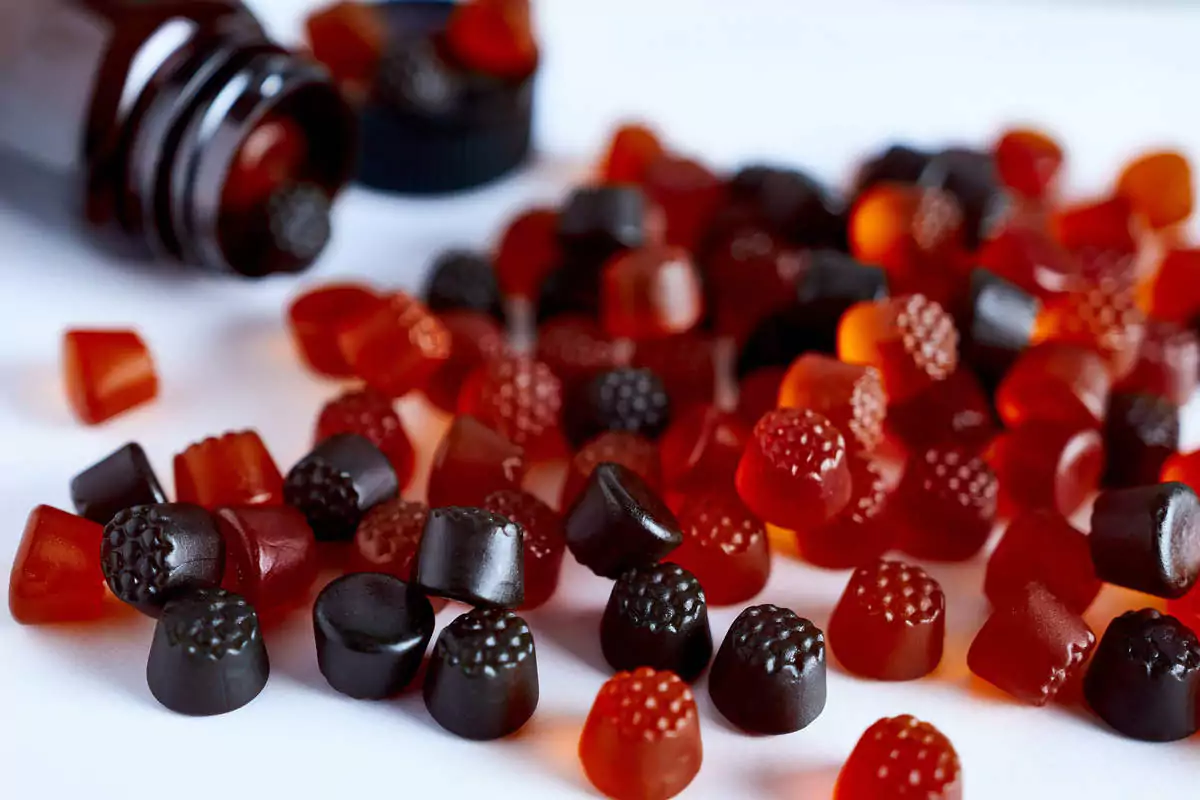What are gummies, and what promises do they make to consumers?
They stand out from other galenicals because they are easy to swallow and have a pleasant taste, often fruity and sweet.
Gummies or jellies are dietary supplements in gel form, often reminiscent of candy. They first appeared and developed in the United States in the late 1990s, with brands such as Nature’s Way and Church & Dwight Co. The first made-in-France products appeared in 2019 with Lashilé Beauty.
They are now available in self-service pharmacies, supermarkets, stores and online distribution. Jellies stand out from other galenic formulas because they are easy to swallow and have a pleasant, often fruity and sweet taste to encourage consumers to take them regularly to improve compliance and therefore the effectiveness of cures.
Jellies contain active ingredients with health benefits, such as vitamins, minerals, antioxidants and probiotics. In Europe, the claims that can be made about the benefits and efficacy of products, also known as “claims”, are regulated by European legislation for food supplements. Authorized claims for these products must be based on solid scientific evidence. In the case of gummies, for example, the following claims can be found:
- “Contributes to the normal functioning of the immune system” for those containing vitamin C, zinc or vitamin D
- “Helps maintain healthy skin” for those containing ingredients such as biotin or collagen
- “Helps reduce fatigue” for those containing B vitamins such as vitamin B12
- “Supports healthy bones and teeth” for those containing calcium, vitamin D or magnesium.
The rise of the global gummies market
The global gummies market is expected to reach USD 7.15 billion by 2025, with annual growth of 8.4% between 2020 and 2025.
If we were to describe the typical profile of today’s dietary supplement consumer, it would be a woman (57%) aged 45 on average. Of all consumers, only a 19% share consumes on a regular basis. Occasional consumers tend to be interested in nutritional supplements at specific times of year, such as seasonal changes or periods of stress.
To broaden their market and appeal to a younger audience, key players in the nutraceutical industry have focused on developing gummies with compositions tailored to the issues affecting young adults, such as weight management, stress management and improved sleep. As a result, the demand has increased, thanks to their pleasant taste, playful appearance and practicality. Jellies can be consumed anywhere, without food or water: a real plus point for people who travel or have an active lifestyle. What’s more, many key players in the industry are riding the wave of social networks and influencers for a highly effective marketing strategy towards this new target.
The global gummies market is therefore growing fast, focusing as much on formulation as on convenience and ease of use, in a market where consumers are increasingly concerned about their health and nutrition, and where there is a strong demand for convenient and enjoyable ways to take dietary supplements to support their well-being. Based on an analysis of Market Research Future, the global gummies market size is expected to reach USD 7.15 billion worldwide by 2025, with annual growth of 8.4% between 2020 and 2025[2].
Gummies are therefore an interesting alternative for people who are concerned about their health and well-being, but who don’t fit in with the proposition of a conventional dietary supplement cure.
Last but not least, nutritional supplements in the form of jellies are often seen as a far more attractive innovation for children than tablets, paving the way for a potentially wider market share.
Will gummies replace capsules?
Gummies offer a number of advantages, but are unlikely to completely replace other galenic formulations on the global market.
The French Agency for Food, Environmental and Occupational Health & Safety (ANSES) warns in an analysis of the risk of overdose and the undesirable consequences they can cause. Indeed, because they’re fun and often taste appetizing, the consumption of jellies can sometimes exceed the recommended daily dose, with potential negative effects, not least because of the ingredients that make up the gummy apart from the active ingredients.
So what’s in a gummy?
The composition of jellies varies considerably depending on the type of dietary supplement, the brand and the specific formulation of the product, but we generally find a share of:
- Sugar or sweeteners: 40 to 60%
- Gelling agent: 20 to 30%
- Flavours: 5 to 10%
- Colorants: 0.1 to 1%
- Vitamins, minerals, plant extracts or other active ingredients: 1 to 10%.
Gummies are therefore mainly composed of sugar or sweeteners, which should not be abused, and which can cause real health problems, particularly for diabetics. What’s more, the concentration of active ingredients in jellies is generally lower than in other forms of nutritional supplements, requiring higher daily doses.
For people with higher nutritional requirements or specific health problems, other forms of nutritional supplements may prove more effective. Today, it is difficult to exceed a 10% share of active ingredients in a gummy, compared with up to 50% in a capsule.
Gummies are therefore a playful galenic that is winning over more and more consumers, especially young ones, thanks to its practicality and taste. Although the jellies offer undeniable advantages, they are not all the same from one brand to the next, and quality is of the utmost importance.
The possibilities opened up by this new galenic are enormous. In the next few years, gummies are likely to be the subject of numerous innovations and evolve in all forms to adapt to market demand: less sugar or additives, more active ingredients… Alcimed can support you in your innovation and development projects related to this market. Don’t hesitate to contact our team!
[1] SYNADIET
[2] Market Research Future
About the author,
Pierre, Consultant in the Alcimed’s Life Sciences team in France



